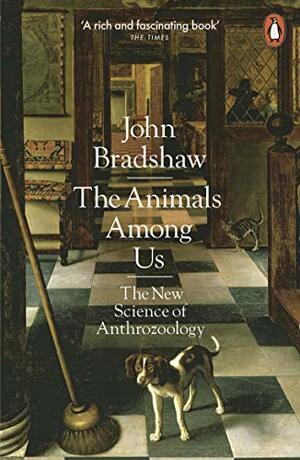
The Animals Among Us: The New Science of Anthrozoology
by John Bradshaw
Genres: Non-fiction, SciencePages: 371
Rating:

Synopsis:The bestselling author of Dog Sense and Cat Sense explains why living with animals has always been a fundamental aspect of being human
Pets have never been more popular. Over half of American households share their home with either a cat or a dog, and many contain both. This is a huge change from only a century ago, when the majority of domestic cats and dogs were working animals, keeping rodents at bay, guarding property, herding sheep. Nowadays, most are valued solely for the companionship they provide. As mankind becomes progressively more urban and detached from nature, we seem to be clinging to the animals that served us well in the past.
In The Animals Among Us, anthrozoologist John Bradshaw argues that pet-keeping is nothing less than an intrinsic part of human nature. An affinity for animals drove our evolution and now, without animals around us, we risk losing an essential part of ourselves.
I found John Bradshaw’s The Animals Among Us initially quite interesting, but ultimately there were a couple of problems: it’s very repetitive, it’s very gender essentialist, and he keeps saying things “cannot be a coincidence” when they can, anything can be a coincidence. Just saying something cannot be a coincidence does not constitute any kind of proof whatsoever that it is not, in fact, coincidence.
He’s also got a pretty cavalier attitude to a number of things, typified by the one I picked up on: he claims that it’s — and I quote — a “fable” that there’s a link between schizophrenia and toxoplasmosis. Not only is it not a fable, but there are also links between Toxoplasma gondii infection and suicide risk, bipolar disease, anxiety, ADHD and OCD. And more! Now I’m not saying all of those are well evidenced, mostly I see stuff like odds ratios and hazard ratios that are suggestive without being conclusive, and we could use more clear-cut explanations of how that’s supposed to be caused and elucidations of stuff like whether it’s infection at any time in your life or infection at a critical period or only if you have both a toxoplasmosis infection and another risk factor… But the point is, it should not be lightly dismissed as a fable.
And sure, it’s a relatively minor point, except he refers to it multiple times and he’s wrong every time. What’s going on here? Has he just decided it’s not a risk and declared that to be the case in spite of the evidence we have? Is he referring to a paper to rule all papers that has disproven all the ones before and after it? Why is he saying this?
This kind of thing always makes me a bit suspicious, and of course, I know my parasitology pretty well (I have an MSc in Infectious Diseases from the London School of Hygiene & Tropical Medicine, one of the top universities for the study of infectious disease in the world — or I will after it’s been officially conferred upon me — and I studied parasitology in the course of that degree) and this jumped out at me. What was there that wasn’t jumping out at me, but is nonetheless equally wrong, dismissive, misguided, etc?
So… read with care, I suppose.
Rating: 2/5

I wonder if he’s had an outsized number of unpleasant encounters dealing with people who heard about that one paper that *was* overreaching and then the popular science reporting on it was even worse, which claimed that T. gondii “definitely” caused suicidal ideation, and then those people used it as a bludgeon to hate cats. There are people who *really* hate cats and have used any science they can get their hands on to justify it and be incredibly rude about it. I’ve had people come onto my stream when my cat video is playing tell me that my cat was evil and should die. ._.
Faranae recently posted…Community Day: Crowdsource your problem prompts
It’s definitely a possibility, just one that’s… inappropriate for him to have expressed like that in the context he was supposed to be writing. It’s pretty misguided [edit: for people to turn on cats because of it] because while cats are a vector, so’s eating infected meat, and it can enter via most links in the carnivorous human food chain (plus unwashed raw vegetables). It’s been a while now and I’d have to look it up, but I have half a memory of the latter actually being the major vector in some countries, not cats, despite cats being the definitive host. All mammals can be hosts.
My guess is that reality lies somewhere in the region of T. gondii being “not necessary, not sufficient” for causing mental illness/neurodivergence, i.e. it’s likely there are other causes, including other infectious diseases, and likely that it’s not sufficient alone. Or maybe it is sufficient alone, but only if you’re infected during gestation or very early infancy, or… whatever. That kind of thing. I also think it’s possible there’s just a strong correlation, like maybe pet allergies during a critical period of brain development, and the T. gondii burden is just a measure of exposure to cats, not the cause of the issue. As far as I know the jury’s very out on all this, but “fable” is definitely the wrong way to talk about it.